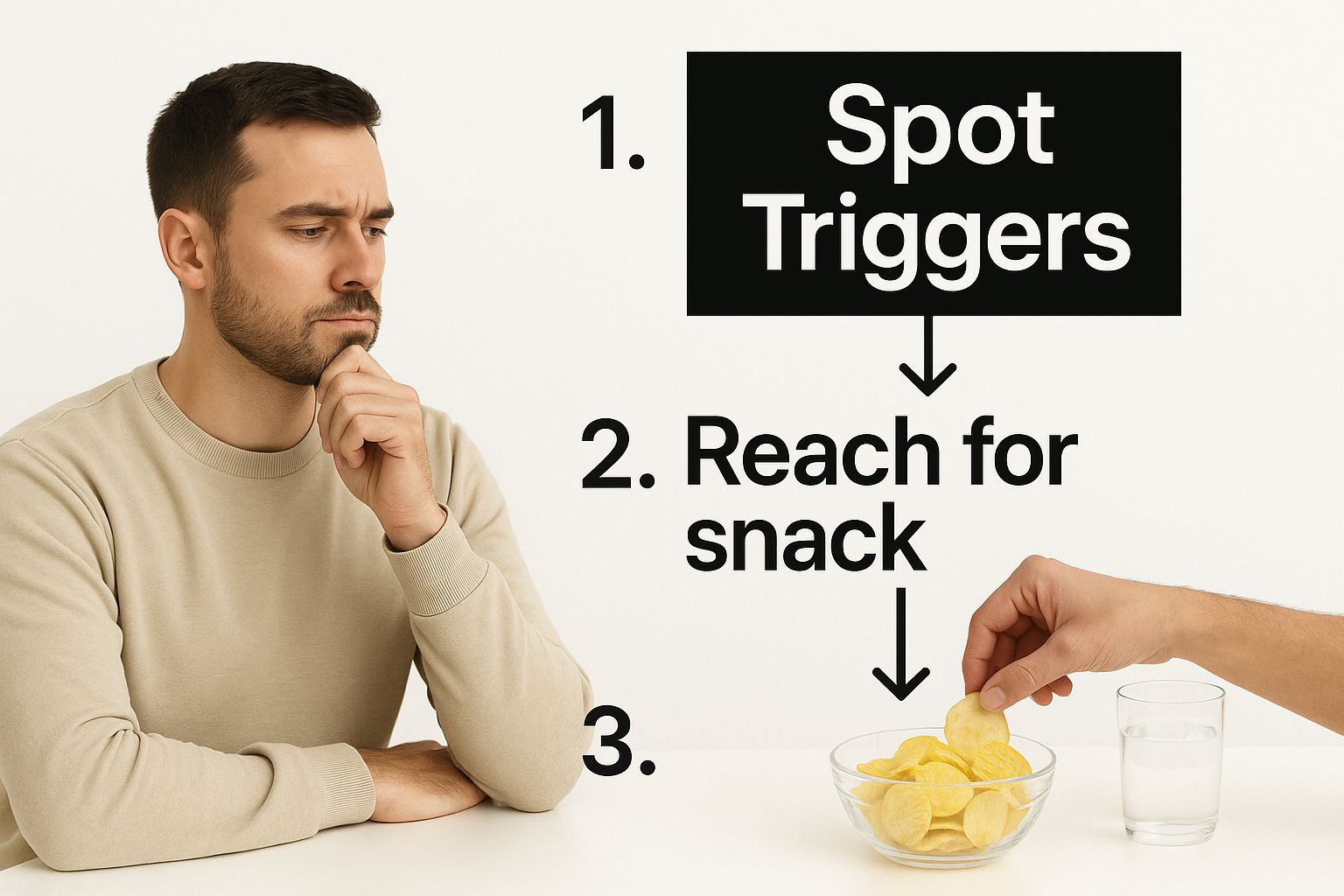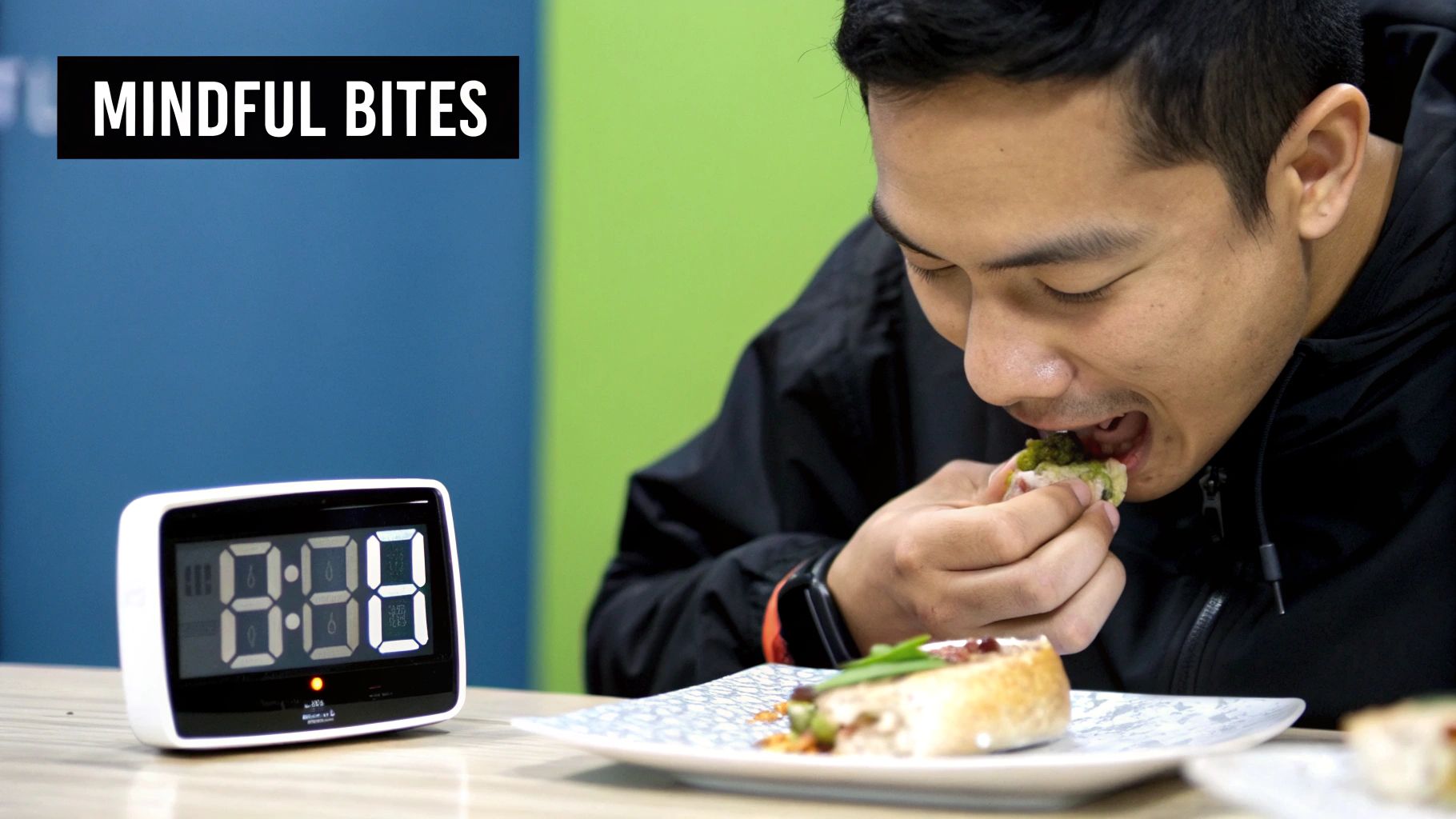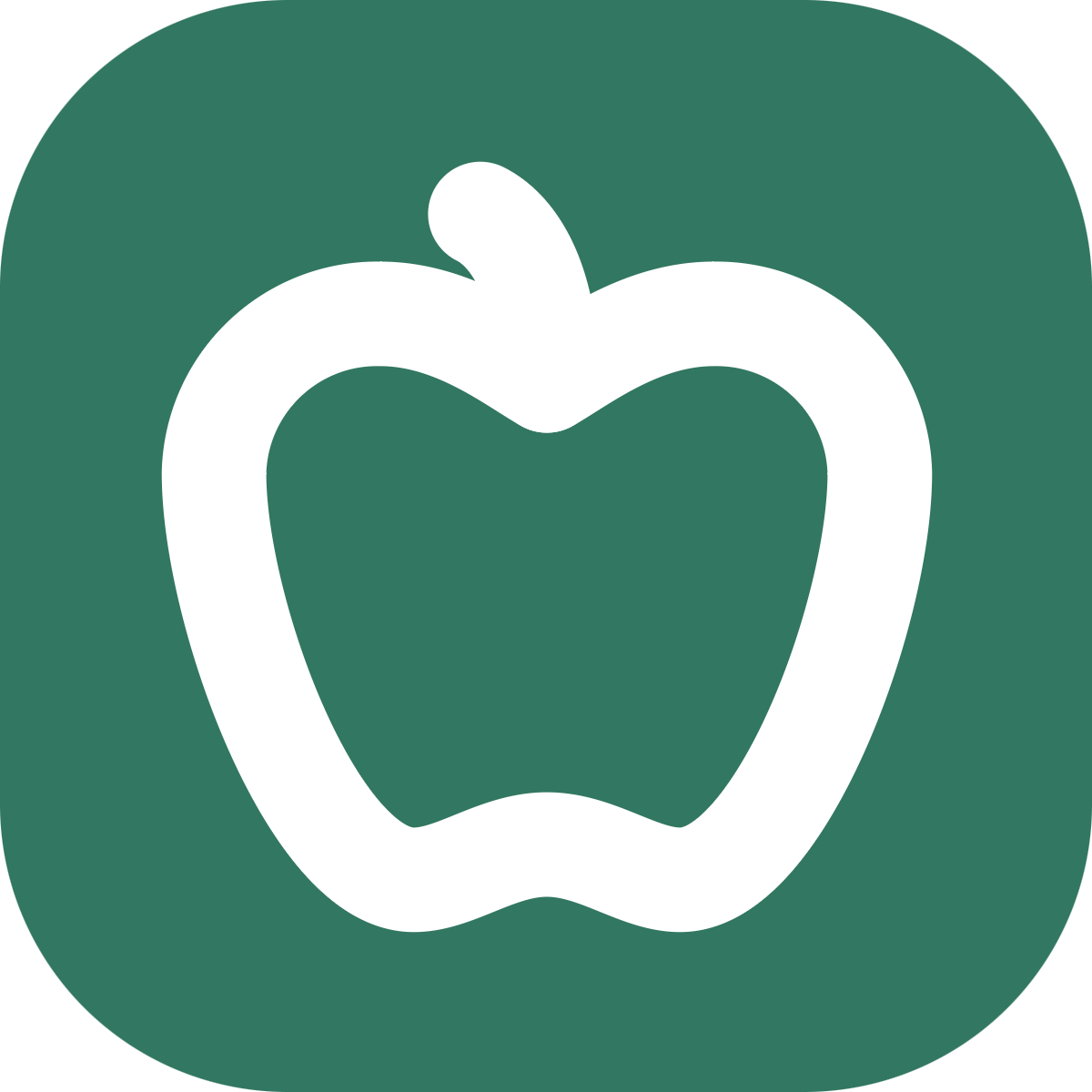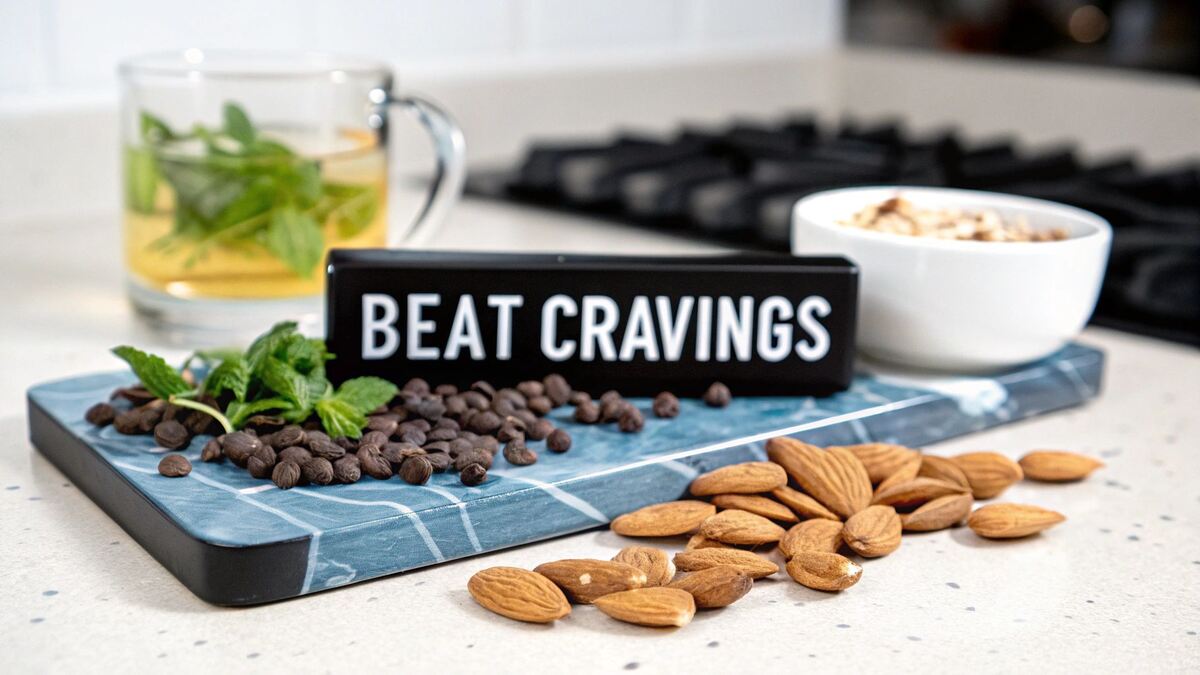How to Overcome Food Cravings: Effective Tips & Strategies
It often feels like a battle you're destined to lose—that sudden, intense urge for something specific, like salty chips or a rich, chocolatey dessert. But here’s a little secret from years of helping people navigate this: understanding the 'why' behind your food cravings is the first, most powerful step toward taking back control.
This isn't about having more willpower. It's about becoming a detective and decoding the signals your mind and body are sending.
Understanding Why You Crave Certain Foods
Cravings are complex. They're rarely as simple as "I'm hungry." Instead, they're intricate messages stemming from a mix of biological needs, deep-seated psychological triggers, and just plain old habits. You might not even realize what's pulling the strings.
The Mix of Mind and Body
Your cravings are a two-pronged attack, coming from both your mind and your body. Each one plays a different role in why you suddenly find yourself raiding the pantry at 10 PM.
Psychological Triggers: These are often tangled up with our emotions and routines. A stressful day at work? Your brain screams for "comfort food." It's a learned response. Or think about the habit of eating popcorn at the movies—the craving hits the moment you sit down in that theater, whether you're actually hungry or not.
Physiological Signals: Your body also sends out SOS signals that we interpret as cravings. A classic example is craving salty foods when you're dehydrated. Your body isn't asking for chips; it's asking for electrolytes. That intense desire for something sweet can also spike when your blood sugar dips, signaling a need for a quick energy boost.
Recognizing where the craving is coming from is half the battle. Is it true hunger, or is it boredom, stress, or just a habit? Asking that simple question creates a crucial pause. That little gap between the urge and your action is where you regain your power.
Cravings are not your enemy. They are simply information. By learning to interpret this information correctly, you can respond to what your body actually needs instead of being controlled by the craving itself.
Let's look at some immediate actions you can take the next time a craving hits. I've put together a few go-to strategies that I've seen work time and time again.
Quick-Start Craving Control Strategies
| Strategy | Why It Works | Quick Tip |
|---|---|---|
| Drink a Full Glass of Water | Dehydration often masquerades as hunger or cravings for salty foods. | Before you reach for a snack, drink 12-16 oz of water and wait 15 minutes. The craving might just disappear. |
| Go for a Brisk 10-Minute Walk | Physical activity can change your brain chemistry, reducing stress and distracting you from the craving. | Step outside for a quick walk around the block. The change of scenery and movement is a powerful pattern interrupt. |
| Eat a Protein-Rich Snack | Protein is highly satiating and helps stabilize blood sugar, tackling the physiological driver of many cravings. | Keep hard-boiled eggs, a small handful of almonds, or Greek yogurt on hand for a quick, effective fix. |
| Practice the 5-Minute Rule | This creates a mental buffer, allowing the initial intensity of the craving to pass. | Tell yourself you can have the food, but you have to wait just 5 minutes. Use that time to do something else entirely. |
These simple tactics can be surprisingly effective at derailing a craving in the moment, giving you the space to make a more conscious choice.
One of the most powerful long-term tools for managing these urges is mindful eating. This isn't a diet; it's a practice of paying full attention to the experience of eating. It teaches you to truly listen to your body and distinguish physical hunger from emotional triggers.
The proof is in the results. A 2015 study, for instance, found that participants trained in mindful eating techniques saw a staggering 55% reduction in binge eating episodes. When you become more aware of your body's signals, you're better equipped to give it what it truly needs.
You can learn more about the global impact of food choices and see how mindful practices contribute to healthier communities. The path forward isn't about trying to eliminate cravings—that’s a losing battle. It’s about understanding them, managing them, and ultimately, taking back control with awareness and a few smart strategies.
Using Mindful Eating to Defeat Cravings
What if you could quiet a food craving without just gritting your teeth and resisting? This isn't about sheer willpower; it's about the power of mindful eating. This isn't some abstract concept—it’s a set of real, practical tools that help you pause, figure out what your body truly needs, and finally overcome those persistent cravings for good.
Mindful eating creates a critical pause—a gap between the urge to eat and the action of eating. It's in that space that you can take back control. You shift from an automatic, knee-jerk reaction to a thoughtful, conscious choice about food.

The simple act of pausing, like you see here, is the first step. It interrupts the habit loop, giving you a chance to see the triggers that send you running for the pantry.
Emotional Hunger vs. Physical Hunger
A huge piece of the mindful eating puzzle is learning to tell the difference between the two types of hunger that fuel our cravings. They can feel almost identical in the moment, but they come from completely different places.
Emotional Hunger: This is the one that ambushes you. It hits suddenly, feels intense, and usually screams for a specific comfort food—like that pint of ice cream or a bag of salty chips. It’s often sparked by feelings like stress, boredom, or sadness. The worst part? Eating to soothe emotional hunger often leaves you with a side of guilt.
Physical Hunger: This is your body’s genuine request for fuel. It’s a slow burn, building up gradually. It doesn't demand a particular food; you're just hungry, and a balanced meal will do the trick. Once you're full, you feel satisfied, not remorseful. It’s a biological signal, plain and simple.
Just learning to spot which one you're feeling is a total game-changer. The next time an urge hits, ask yourself: "Did this feeling sneak up on me, or did it just crash the party?" The answer tells you everything you need to know.
Your Five-Senses Craving Check-In
When a powerful craving takes hold, don't just give in. Try this instead. It’s a simple exercise that uses your five senses to ground you in the present moment, helping you look at the craving objectively instead of being controlled by it.
- See: Really look at your surroundings. What three colors do you see? Notice the shapes and textures around you.
- Hear: Tune in your ears. What can you actually hear right now? Maybe it's the quiet hum of your computer, traffic outside, or your own breathing.
- Feel: Pay attention to physical sensations. Feel your feet flat on the floor. Notice the fabric of your clothes against your skin. Is the air warm or cool?
- Smell: Take a gentle sniff. Can you pick up any scents in the air?
- Taste: What does your mouth taste like right now? It might be nothing at all, and that’s fine. Just notice it.
This quick check-in acts like a circuit breaker for that obsessive craving loop in your brain. By shifting your focus from the food you think you need to your immediate physical reality, the intensity of the urge almost always fades.
This simple pause gives you breathing room. It weakens the craving’s grip just enough for you to ask, "Am I actually hungry, or am I just looking for comfort?"
This idea of building body awareness doesn't have to stop with food. Practices like mindful movement can also make a huge difference, strengthening the connection between your mind and body. The more in tune you are, the better you'll get at managing cravings, both at the dinner table and away from it.
Building Your Anti-Craving Nutritional Plan

What you eat can either be your strongest weapon against cravings or the very thing that triggers them. The secret is building a nutritional plan that keeps your blood sugar stable. This isn't about restriction; it's a proactive defense against the dramatic energy dips that have your brain demanding a quick, sugary fix.
Think of your blood sugar as a fuel gauge. When it's steady, you feel great and can cruise through your day. But when it plummets, your body’s alarm system goes off, demanding immediate energy—and that's when cravings for sugar and high-carb foods hit hard. This is precisely where smart nutrition can step in and change the game.
The Craving-Crushing Trio: Protein, Fiber, and Fat
To keep that fuel gauge steady, your focus should be on three powerful nutrients that work together to keep you full, satisfied, and energized. Making sure each meal features this trio is the cornerstone of an anti-craving diet.
Protein: This is your satiety superstar. Protein digests slowly, which means you feel full and satisfied for much longer than you would after eating simple carbs. Including a source of lean protein—like chicken, fish, eggs, or beans—at every meal is one of the best ways to prevent that dreaded mid-afternoon slump.
Fiber: You'll find fiber in whole grains, fruits, vegetables, and legumes. Its magic lies in how it slows the absorption of sugar into your bloodstream, preventing the sharp spikes and crashes that kickstart cravings. A high-fiber breakfast, for instance, can set a stable, balanced tone for your entire day.
Healthy Fats: Don't fear the fat! Foods rich in healthy fats like avocados, nuts, seeds, and olive oil are incredible for promoting a sense of fullness. They provide a slow, steady release of energy that helps keep both hunger and cravings from making an appearance.
When you combine these three, you create a powerful synergy that balances your blood sugar and keeps you satisfied. Essentially, you shut down cravings before they even get a chance to start.
Smart Food Swaps to Beat Cravings
Knowing what to eat is one thing, but actually doing it day-to-day is another challenge entirely. The goal isn’t about deprivation; it's about making smarter choices that are just as, if not more, satisfying.
So, when that 3 PM slump hits and you're eyeing a candy bar, try a handful of almonds with a square of dark chocolate (at least 70% cacao) instead. You get protein and healthy fats from the nuts for lasting energy, while the dark chocolate provides a hint of sweetness packed with antioxidants and far less sugar.
A common mistake is trying to banish all "bad" foods overnight. A much better approach is to upgrade your choices. Focus on adding nutrient-dense, craving-fighting foods rather than just subtracting the unhealthy ones.
Here are a few more simple swaps to get you started:
| Craving This | Try This Instead | Why It Works |
|---|---|---|
| Potato Chips | Air-popped popcorn with a sprinkle of nutritional yeast | You still get that salty, crunchy satisfaction, but with whole-grain fiber and a cheesy kick from the yeast. |
| Sugary Soda | Sparkling water with a splash of fruit juice & fresh mint | This delivers the fizz you're after without the massive sugar bomb that leads directly to a crash. |
| Ice Cream | Greek yogurt with berries and a drizzle of honey | This packs a protein punch, satisfies your sweet tooth with natural sugars, and adds a dose of fiber. |
These small, consistent adjustments can make a world of difference. When you fuel your body with the right building blocks, you create a foundation of strength that makes it so much easier to make mindful, healthy choices all day long.
Strategic Meal Planning to Stop Cravings Before They Start

The best way to win the fight against cravings is to make sure the fight never even starts. This isn't about white-knuckling it through your day with sheer willpower. It’s about creating a smart, proactive system that stops cravings from getting a foothold in the first place.
Think of strategic meal planning as your secret weapon. By keeping your energy and blood sugar levels on an even keel, you sidestep the physical triggers that send you running for the nearest bag of chips.
When you have delicious, satisfying meals ready to go, you completely remove the "what's for dinner?" decision fatigue that so often ends with a less-than-ideal choice. It's all about making the healthy option the easiest option.
Anchor Your Day with Balanced Meals
A consistent meal schedule is the bedrock of any solid anti-craving plan. One of the biggest mistakes I see people make is skipping meals, especially breakfast. It’s a recipe for disaster.
Go too long without eating, and your blood sugar takes a nosedive. What happens next? Your body screams for a quick energy fix, which usually means sugar or refined carbs. Sound familiar?
Instead, focus on three balanced meals at regular times. Each one should feature a powerhouse combination of protein, fiber, and healthy fats. This trio is magic—it slows down digestion, keeps you feeling full, and provides a steady stream of energy. No more wild swings in hunger or mood.
The real goal here isn't to follow some rigid, complicated diet. It’s simply to build a reliable eating rhythm that works with your body's natural energy cycle, effectively pulling the plug on most craving triggers.
This consistency trains your body to expect fuel at certain times, which means fewer random hunger pangs and desperate trips to the vending machine.
Plan for Your Weakest Moments
We all have them. Those predictable times of day when our defenses are down. For so many people, it’s that dreaded 3 PM afternoon slump or that "I'm too tired to think" feeling right after work. These are your high-risk moments when cravings hit with a vengeance.
Knowing this is your advantage. You can plan for these moments instead of just letting them happen.
Here’s how you can prep your defenses:
- For the Afternoon Slump: Have pre-portioned snacks ready to grab. My go-to options are things like apple slices with a spoonful of almond butter, a container of Greek yogurt, or a small bag of homemade trail mix.
- For Post-Work Exhaustion: Plan for "emergency meals." I always have two or three super simple, healthy options I can throw together in under 15 minutes. Think pre-cooked chicken strips tossed into a bagged salad or a hearty lentil soup I made over the weekend.
When you anticipate these tough spots, you're no longer reacting—you're responding with a pre-planned solution that actually satisfies you without derailing your goals. For anyone who feels overwhelmed by the planning process, tools like an AI meal planner can be a huge help, offering customized ideas that fit your life.
A Practical Anti-Craving Meal Structure
To see how this all comes together, let’s look at a sample daily structure. Remember, this is a flexible template, not a strict diet, designed to inspire balanced, craving-proof meals.
Here's a sample blueprint for structuring your day to keep blood sugar stable and cravings away.
Sample Anti-Craving Daily Meal Structure
| Meal/Snack Time | Key Components | Example Foods |
|---|---|---|
| Breakfast (7-8 AM) | Protein + Fiber + Healthy Fat | Scrambled eggs with spinach and a side of avocado on whole-wheat toast. |
| Lunch (12-1 PM) | Lean Protein + Complex Carbs + Veggies | Grilled chicken salad with quinoa, mixed greens, and a light vinaigrette. |
| Snack (3-4 PM) | Protein + Fiber | Greek yogurt with a handful of berries and chopped walnuts. |
| Dinner (6-7 PM) | Lean Protein + Lots of Veggies | Baked salmon with roasted broccoli and a side of sweet potato. |
By following a simple structure like this, you’re constantly giving your body the nutrient-dense fuel it needs. When your body is truly nourished, you’ll be amazed at how quiet those intense cravings become.
Lifestyle Habits That Tame Your Toughest Cravings
Food cravings are rarely just about the food itself. More often than not, they’re deeply tangled up in our daily routines and lifestyle choices. Before you even think about what’s for dinner, you can set yourself up for success by focusing on three pillars that have a surprising amount of power over your appetite: sleep, stress, and hydration.
Think of these as the foundation of your house. If the foundation is shaky, everything else becomes unstable. You could be eating perfectly balanced meals, but if you're chronically sleep-deprived or stressed out, you’ll still find yourself wrestling with intense, hard-to-ignore urges.
Prioritize Restorative Sleep
Just one night of bad sleep can throw your appetite-regulating hormones into complete chaos. When you're tired, your body amps up its production of ghrelin, the "hunger hormone," which drives you to eat. At the same time, your levels of leptin, the hormone that signals fullness, take a nosedive.
This hormonal double-whammy creates a perfect storm for cravings, making you feel hungrier and far less satisfied by what you eat.
Aiming for 7-9 hours of quality sleep each night is one of the best things you can do. A simple "wind-down" routine can make a huge difference. Try a few of these:
- Turn off all screens at least an hour before bed. The blue light is a known sleep disruptor.
- Take a warm bath or shower to help relax your body.
- Read a physical book instead of scrolling on your phone.
- Sip on something calming. To build sustainable anti-craving habits, you can explore the world of non-caffeinated teas.
Master Your Stress Response
For so many of us, stress is a massive craving trigger. When you're feeling frazzled, your body releases cortisol, a hormone that cranks up your appetite and makes you seek out high-fat, sugary "comfort" foods. It's an old survival mechanism that, in our modern lives, often works against us.
You can't always eliminate stress, but you can manage your reaction to it. Simple mindfulness practices are surprisingly effective.
The next time you feel that stress-induced hunger pang, pause and try a quick breathing exercise. Inhale slowly for four counts, hold for four, and then exhale slowly for six. Repeat this just five times. This simple act can calm your nervous system and give you the mental space to decide if you're truly hungry or just stressed.
Stay Consistently Hydrated
Dehydration is a sneaky culprit behind a lot of food cravings. The symptoms of being even mildly dehydrated—like fatigue, brain fog, and low energy—feel remarkably similar to hunger. Your brain can easily mistake thirst for a need for food, sending you to the pantry when all you really need is a glass of water.
Before you reach for a snack, make it a habit to drink a full glass of water and wait 15 minutes. You’ll be surprised how often the craving completely vanishes.
The best strategy is to keep a water bottle with you throughout the day. It’s a constant visual reminder to sip consistently, not just when you feel parched. Making these small, steady changes to your lifestyle habits builds a powerful defense against even your toughest cravings.
Your Questions About Food Cravings Answered
Diving into your relationship with food is bound to bring up some questions. Even with the best strategies in place, real life gets messy. Let's walk through some of the most common questions I get from people learning to get a handle on their food cravings.
Think of this as your go-to resource for those tricky moments. The more prepared you are, the more confident you'll feel when a craving inevitably pops up.
How Long Does It Take to Get Rid of Food Cravings?
This is the big one, and the honest answer is: it's different for everyone. There’s no magic switch.
However, most people I've worked with start to feel a real shift within a few weeks of consistently applying the right techniques. By focusing on things like stabilizing your blood sugar with balanced meals, eating mindfully, and getting a handle on stress, you'll notice the cravings don't hit as hard or as often. The goal isn't a life completely free of cravings—it's about getting to a place where they don't run the show.
Is It Okay to Give In to a Craving Sometimes?
Yes, absolutely! The goal here is control, not a prison of deprivation. In fact, being overly restrictive is a classic recipe for disaster, often leading to a full-blown binge later on.
If you make a conscious decision to enjoy something you're craving, do it. The key is to do it mindfully and without an ounce of guilt. Go ahead and savor a small, truly satisfying portion.
The real problem is the mindless, automatic eating that cravings can trigger. It's the difference between deliberately enjoying one perfect scoop of ice cream versus finding yourself at the bottom of the pint, wondering what just happened.
Trying to fight a craving with pure willpower is like holding your breath—you can only do it for so long. A much smarter approach is to create a little space. A quick walk around the block, a big glass of water, or even a five-minute distraction can be enough to let that initial intense urge fade, putting you back in control.
What Is the Best Thing to Do When a Strong Craving Hits?
When a really intense craving blindsides you, your best friend is the 'Pause and Delay' technique. It's a simple, three-step response that can break the craving's spell almost immediately.
Here's how it works:
Stop and Breathe: The second you feel that urge, just stop. Take five slow, deep breaths. This simple act is surprisingly powerful—it interrupts that knee-jerk reaction in your brain.
Hydrate First: Before you do anything else, drink a big glass of water. It's incredible how often our bodies mix up the signals for thirst and hunger. Sometimes, this is all it takes.
Set a Timer: Give yourself permission to have the food, but with one condition: you have to wait 15-20 minutes. Use that time to get busy with something else. Call a friend, tidy up a room, or step outside for some fresh air.
More often than not, by the time that timer dings, the craving will have either vanished or weakened so much that it's easy to ignore. You're back in the driver's seat.
Ready to stop reacting to cravings and start preventing them? The AI Meal Planner creates personalized meal plans that keep you satisfied and your blood sugar stable, making it easier than ever to achieve your health goals. Discover your custom meal plan at https://ai-mealplan.com today!
AI-powered nutrition
Get Your Personalized Meal Plan
AI creates the perfect meals for your goals, lifestyle, and taste.
Start Your Journej
